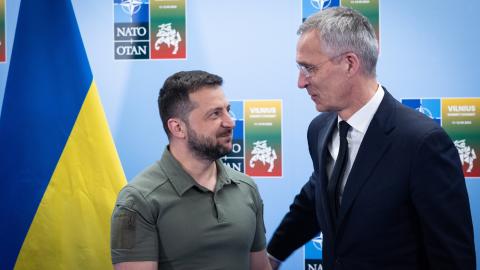Heads of state and government leaders from the 32 NATO members will meet in Washington over three days in July for a major summit that will mark the 75th anniversary of the alliance. Under normal circumstances it would be a time of celebration — but these are not normal times.
While there is indeed a lot for NATO to celebrate, the security situation in Europe is bleak. Russia’s invasion of Ukraine has entered its third year and there is no end in sight. This war is the largest in Europe since NATO was founded in 1949. Instead of backslapping and plaudits, all eyes during the summit ought to be on the war and what NATO should do about Ukraine.
In terms of providing military, economic, and humanitarian assistance, the countries of NATO have played an important role in helping Ukraine. The alliance has also done a good job at bolstering its defenses in eastern Europe to deter any further aggression in the region.
Before last year’s summit in Vilnius, expectations were high for Ukraine’s membership of NATO, but many who hoped for a formal invitation to join the alliance were disappointed. This time, NATO wants to avoid a repeat of that. This is why some NATO leaders, especially US President Joe Biden and German Chancellor Olaf Scholz, are scrambling to lower expectations of the summit’s outcome regarding Ukraine.
NATO and Ukraine have had formal relations since the 1990s, but in the early days the relationship was at a low level. In 1997, when the now defunct NATO-Russia Council was created, the NATO-Ukraine Commission was also established. This helped to deepen the relationship between the Ukraine and NATO, but even so, over the course of the subsequent decade there was no serious discussion of Ukrainian membership.
This changed in 2008 at the Bucharest summit, when NATO agreed that Ukraine would some day become a member. In reality, the alliance did little to move Ukraine toward membership in the years that followed. Meanwhile the Ukrainian government showed little interest in taking the meaningful steps required to join. For example, there was even a stipulation in Ukraine’s constitution at the time that prevented it from joining security alliances such as NATO.
When Russia first invaded Ukraine in 2014, it had nothing to do with NATO. Nobody at the time seriously considered the possibility of Ukraine joining the alliance. Instead, the trigger was over Ukraine possibly signing a free trade deal with the EU instead of pursuing closer economic ties with the Moscow-led Eurasian Economic Union. The dynamics between Ukraine and NATO changed drastically after 2014. Ukraine amended its constitution to allow it to join security alliances such as NATO, and has made genuine efforts to do so.
Since Russia’s massive invasion of Ukraine in 2022, Kyiv has redoubled its efforts to join NATO. When Russia illegally annexed of Ukraine’s Donetsk, Luhansk, Kherson and Zaporizhzhia regions in September 2022, President Volodymyr Zelensky called for Ukraine’s “accelerated accession” into NATO days later in response.
While NATO fell short of extending an invitation to Ukraine at the summit last year, it did agree to the common position that “Ukraine’s future is in NATO.” Since then, there has not been much progress in terms of what the next steps should be. While all members agree that Ukraine will join NATO some day, putting a timeline on this ambition remains deeply divisive inside the alliance.
So what is a realistic outcome for Ukraine at the Washington summit? Those hesitant to extend even an invitation to Kyiv are worried that Ukraine’s membership would mean an automatic war with Russia. But Zelensky himself has said on several occasions that he knows Ukraine will not join NATO while it is at war with Russia, so there would be no harm in NATO extending an invitation for Ukraine to join the alliance but with the final date of membership to be determined after the conflict ends. An invitation does not mean immediate and automatic membership, but it is a sign of commitment. This is the bare minimum that Ukraine deserves.
Overall, the past 75 years have been a success for NATO. The Cold War ended without a shot being fired and the alliance has started to adapt well to the challenges of the 21st century. NATO’s success means that it is a club that countries want to join, and Ukraine is no exception. No country has ever been forced or pressured into joining the alliance. And contrary to popular belief in some quarters, no promises were made to Russia in the 1990s that NATO would not add new members from eastern Europe.
Since NATO was created in 1949, successive rounds of enlargement have added members to the alliance, while bringing more stability and security across Europe. Now is the time for NATO leaders to recognize the historical time in which we are living, and act accordingly. NATO has a lot to be proud of, but instead of celebrating its history at this summer’s meeting, it should make history by extending an invitation for Ukraine to join the alliance.
The leaders of NATO need to start working overtime to find a consensus on what the outcome will be for Ukraine. A failure to resolve this issue before the next summit would be a terrible way to mark the 75th anniversary of the alliance.
















